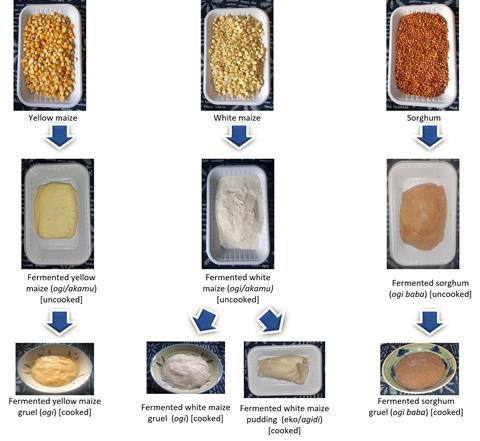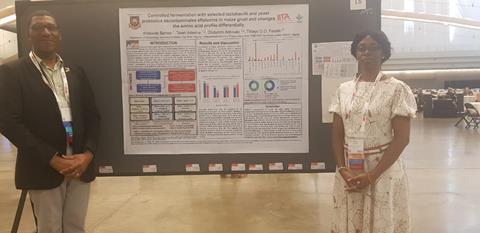Traditional fermented foods have a long history, and the microbiome involved in fermentation has been gaining relevance in recent times. Nigeria is rich in diverse traditional cultures and cuisine with different fermented foods.
In my laboratory, we work on various traditional fermented foods such as starchy-based tuber crops, cereal grains, dairy products and vegetable condiments. These constitute the essential dietary components, processed mainly through artisanal practices with spontaneous/back-slopping procedures involving rudimentary utensils. Due to the limited data collection during these processes, our understanding of the role of fermenting microorganisms in enhancing flavour, aroma and taste is essential to understanding the dynamics in play.

Until recently, the characterisation of the fermenting microorganisms involved in producing these traditional foods has been by phenotypic means. However, to better understand the biodiversity of these foods, the use of both culture-dependent and -independent techniques is essential. Our research focus has been understanding the dynamics and biodiversity of the microorganisms involved in the fermentation of traditional Nigerian foods towards developing starter cultures to improve the nutritional composition, probiotic potential, food safety and health benefits of these foods.
Probiotic potential
Fermented cereal gruel (ogi or akamu) is an essential meal consumed in Nigeria and sub-Saharan Africa as breakfast, weaning food for children, and food choices for the elderly and convalescents. Ogi is made from fermented maize, millet and sorghum. The cereal grains are made up of essential nutrients, which are bioavailable at fermentation, but some can be lost during the slurry processing. Also, fermented starchy-based tuber crops such as cassava are vital components of the diet of Nigerians and other sub-Saharan Africans. Products like gari (roasted fermented cassava grits), fufu (a stiff pudding made from fermented cassava slurry) and lafun (a stiff pudding made from flour derived from fermented cassava) are made from the retting of the cassava tubers and processed in different ways depending on the product and the ethnic preference.
My laboratory has studied microorganisms like lactic acid bacteria, and yeasts (Weissella cibaria, Lactobacillus plantarum and Pichia kudriavzevii) derived from ogi, wara (African soft cheese) and retted cassava mash for probiotic potential and have been employed in the biosorption of heavy metals in experimental animals. During our research, we also educate the cottage industry and artisanal producers to use whole (rather than damaged) grains in producing cereal gruels for enhanced nutrition and benefits from the fermentation process.

Food safety
My laboratory collaborates closely with Dr Titilayo DO Falade of the Pathology/Mycotoxin/Aflasafe Unit of the International Institute of Tropical Agriculture (IITA), Ibadan. Collaboratively, we have researched food safety concerns, including food adulteration and mycotoxin decontamination of the traditional fermented foods, especially ogi.
Food product such as the ogi baba (fermented sorghum gruel) is usually adulterated with sorghum leaf sheath extracts for economic benefits as the ogi from sorghum commands more financial value than ogi from maize. In our collaborative research, we developed a model for rapid identification of adulterated ogi using visible-near infrared (vis-NIR) spectrometry. Rapid detection methods like this are useful for assessing food quality attributes non-invasively, especially in societies with weak monitoring systems.
There is a high prevalence of mycotoxins in crops in sub-Saharan Africa. In collaboration with Titilayo Falade, my laboratory researched the decontamination of aflatoxins in ogi. Through research, probiotics were identified, and decontaminated ogi was spiked with toxigenic Aspergillus flavus. The results indicated that lactic acid bacteria (Lactiplantibacillus plantarum and Limosilactobacillus fermentum) and yeasts (two different strains of Candida tropicalis) possessed probiotic potential and could decontaminate aflatoxins produced by the toxigenic A. flavus with intraspecies and interspecies differences.

Bioactive compounds
My research group, in collaboration with Prof. Kalidas Shetty and Dr Dipayan Sarkar of the Department of Plant Sciences, North Dakota University, Fargo, USA, worked on bioactive compounds produced in the traditional fermentation of ogi using some compatible food synergies such as tiger nuts and sesame seeds. The results we obtained gave an insight that ogi fermented, in combination with these food synergies, can be targeted to enhance the requirements of early childhood stages of nutritional benefits and late adult stages of non-communicable disease-targeted functional qualities.









No comments yet